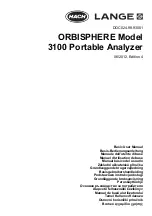
7
Installation of the Load Stand
®
II
1.
Inspect the load stand. With orders of different types,
make sure the correct load stand will be installed.
2. Measure the No Load Output to ensure it’s ±50 mV.
3. Raise the vessel.
4. Inspect the bottom of the vessel mounting surface to
ensure it is perfectly flat. Check for angular misalign
-
ment. Remove any debris from the mounting surface.
Depending on the foundation (concrete or beam mount-
ing) refer to the respective indications on figure 2 and
figure 3.
5. Mount the Load Stands on the foundation.
a) Place the customer-supplied leveling nuts and hard-
ened washer on each anchor bolt on the load stand.
Check the angular alignment.
b) Carefully place the Load Stand
®
on the leveling
nuts/washers, aligning the mounting holes with
the foundation anchor bolts. The alignment should
allow the load stand to easily slide onto the anchor
bolts.
c) Place the customer-supplied hardened washer and
nut on each anchor bolt. Do not fully tighten the
nuts at this time. Leave a 6 mm (1/4") gap between
the nut and washer to allow for positioning the Load
Stand.
d) Repeat Steps A through D for each Load Stand.
e) Record the no load output by connecting the
electronics and following chapter “Shimming of the
Load Stand”.
6. Mount the vessel on the Load Stands:
Caution
Use proper supports to prevent the vessel from tipping
or falling.
Note
On 22,680 kg (50,000 lb) or larger Load Stands, a pry
bar may be used at the base of the Load Stand
®
to gently
move it into position.
Caution
If the vessel hole pattern does not match up with the
Load Stand
®
hole pattern, modify the mounting holes on
the vessel. Do not force the Load Stand
®
into position by
hammering or by tightening the mounting bolts.
Installation
a) Slowly lower the vessel until it is resting on the Load
Stand
®
assemblies. Alignment pins may be used to
help guide and position the vessel.
b) Center the Load Stand
®
top mounting holes with the
vessel mounting holes, using the clearance available
from the Load Stand
®
bottom mounting holes.
c) Place a rubber washer on each customer-provided
top bolt. Place the four top bolts through the vessel,
rubber pad, and Load Stand
®
mounting holes.
d) Place a rubber washer and customer provided nut on
the end of each bolt. Tighten the nuts finger tight.
Do not compress the rubber washers at this time.
7. Perform preliminary leveling shimming:
a) Inspect the installation for gaps between the vessel
mounting plate and the Load Stand.
b) Eliminate gaps by doing one or a combination of the
following:
· Turn the leveling nuts, only to raise the entire
load stand.
· Install one or more full shims above the Load
Stand
®
rubber pad. Two shims are provided by
Anderson-Negele with each Load Stand.
· Install one or more partial shims above the Load
Stand
®
rubber pad. Two shims are provided by
Anderson-Negele with each Load Stand. Using the
Load Stand
®
flange as a guide, mark the required
shim shape on a thin piece of cardboard. Use this
as a template to cut the required shape from a
full shim.
Summary of Contents for Load Stand II
Page 23: ...23 Notes ...
Page 24: ...2 4 Notes ...








































